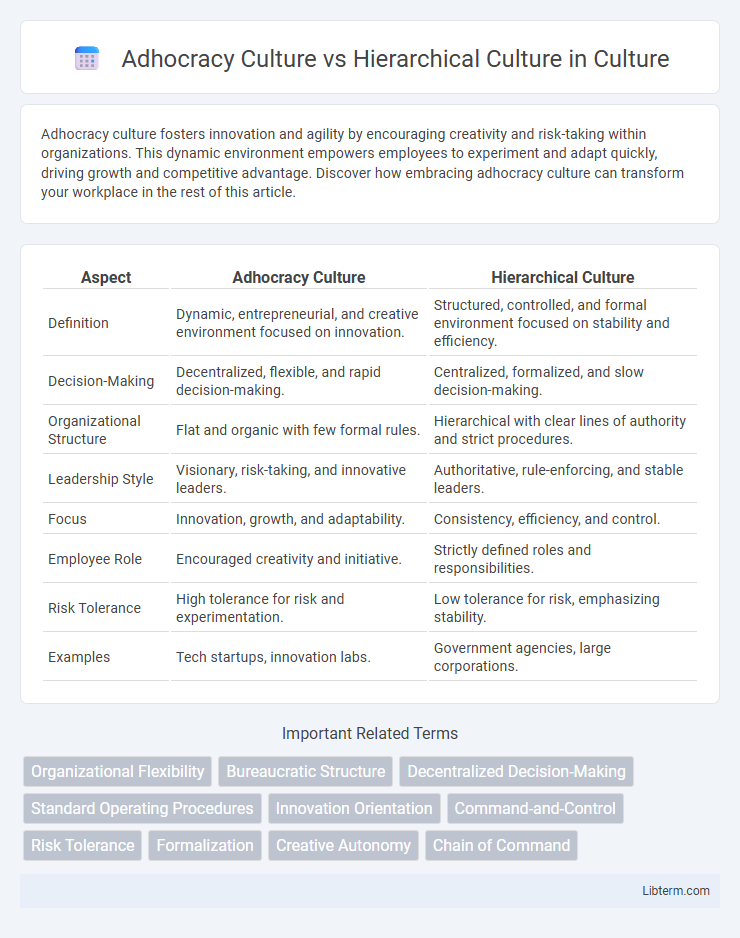Adhocracy culture fosters innovation and agility by encouraging creativity and risk-taking within organizations. This dynamic environment empowers employees to experiment and adapt quickly, driving growth and competitive advantage. Discover how embracing adhocracy culture can transform your workplace in the rest of this article.
Table of Comparison
| Aspect | Adhocracy Culture | Hierarchical Culture |
|---|---|---|
| Definition | Dynamic, entrepreneurial, and creative environment focused on innovation. | Structured, controlled, and formal environment focused on stability and efficiency. |
| Decision-Making | Decentralized, flexible, and rapid decision-making. | Centralized, formalized, and slow decision-making. |
| Organizational Structure | Flat and organic with few formal rules. | Hierarchical with clear lines of authority and strict procedures. |
| Leadership Style | Visionary, risk-taking, and innovative leaders. | Authoritative, rule-enforcing, and stable leaders. |
| Focus | Innovation, growth, and adaptability. | Consistency, efficiency, and control. |
| Employee Role | Encouraged creativity and initiative. | Strictly defined roles and responsibilities. |
| Risk Tolerance | High tolerance for risk and experimentation. | Low tolerance for risk, emphasizing stability. |
| Examples | Tech startups, innovation labs. | Government agencies, large corporations. |
Understanding Adhocracy Culture
Adhocracy culture prioritizes innovation, flexibility, and risk-taking, fostering a dynamic environment where creativity and entrepreneurial spirit drive organizational growth. This culture emphasizes decentralized decision-making and values adaptability to rapidly changing markets, contrasting sharply with hierarchical culture's focus on stability, formal procedures, and clear chains of command. Organizations with adhocracy culture often excel in industries requiring constant innovation, such as technology and startups, as they encourage experimentation and collaboration across teams.
Defining Hierarchical Culture
Hierarchical Culture is characterized by structured procedures, clear chains of command, and well-defined roles that emphasize stability, control, and efficiency within an organization. It relies on standardized rules and formalized policies to ensure predictability and consistency in decision-making processes. This culture type prioritizes order and uniformity, which contrasts with the adaptability and innovation seen in Adhocracy Culture.
Core Principles of Adhocracy Culture
Adhocracy culture prioritizes innovation, flexibility, and risk-taking, fostering an entrepreneurial environment where creativity drives decision-making. It thrives on adaptability and decentralized authority, empowering employees to experiment and respond quickly to changing market demands. This contrasts sharply with hierarchical culture, which emphasizes structured procedures, formal roles, and stability to maintain control and efficiency.
Key Characteristics of Hierarchical Culture
Hierarchical culture is characterized by a structured and formalized work environment with clear lines of authority, standardized procedures, and consistent control mechanisms. Decision-making is centralized, emphasizing stability, efficiency, and adherence to rules to maintain order and predictability. Organizations with hierarchical culture prioritize formal roles, uniformity, and systematic coordination to achieve long-term goals and minimize risks.
Leadership Styles in Adhocracy vs Hierarchical Cultures
In Adhocracy cultures, leadership is characterized by innovation, flexibility, and risk-taking, with leaders acting as visionary entrepreneurs who encourage creativity and adapt quickly to change. Hierarchical cultures emphasize structured, formalized leadership where authority is centralized, roles are clearly defined, and decision-making follows established protocols to ensure stability and efficiency. The contrast between these leadership styles reflects the underlying values: Adhocracy leaders inspire experimentation and empowerment, whereas Hierarchical leaders maintain control and order within the organizational framework.
Decision-Making Processes: Flexibility vs Control
Adhocracy culture emphasizes flexible decision-making processes that encourage innovation and rapid responses to changing environments, enabling teams to experiment and adapt without rigid constraints. Hierarchical culture prioritizes controlled decision-making through established protocols and clear authority lines, ensuring consistency, stability, and risk mitigation. Organizations with adhocracy cultures thrive in dynamic markets, while hierarchical cultures excel in maintaining order and efficiency in structured settings.
Innovation and Risk-Tolerance in Both Cultures
Adhocracy culture thrives on innovation by encouraging creativity and embracing risk-taking to drive dynamic change and breakthrough solutions. Hierarchical culture prioritizes stability and control, resulting in lower risk tolerance and a structured decision-making process that can hinder rapid innovation. Organizations with adhocracy culture excel in fast-paced industries requiring adaptability, while hierarchical culture suits environments demanding consistency and compliance.
Employee Motivation and Engagement
Adhocracy Culture fosters employee motivation and engagement by encouraging innovation, creativity, and risk-taking, which empowers individuals to contribute unique ideas and feel valued. In contrast, Hierarchical Culture often relies on formal rules, clear structure, and top-down decision-making, which can limit autonomy and reduce intrinsic motivation among employees. Research indicates that organizations embracing adhocracy tend to experience higher engagement levels due to increased employee involvement and opportunities for personal growth.
Business Outcomes: Adaptability vs Stability
Adhocracy culture drives business outcomes through adaptability by fostering innovation, rapid decision-making, and flexibility to respond to market changes. Hierarchical culture emphasizes stability by maintaining structured processes, clear roles, and consistent procedures that reduce risk and enhance operational efficiency. Companies with adhocracy cultures excel in dynamic environments, while hierarchical organizations prioritize reliability and long-term control for predictable results.
Choosing the Right Culture for Your Organization
Selecting the right organizational culture depends on your business goals and operational environment. Adhocracy culture thrives in innovative, fast-paced industries by promoting flexibility, risk-taking, and entrepreneurial thinking, making it ideal for startups and companies pursuing rapid growth. Hierarchical culture emphasizes stability, clear procedures, and control, fitting well with large organizations or those requiring consistent processes and regulatory compliance.
Adhocracy Culture Infographic

 libterm.com
libterm.com